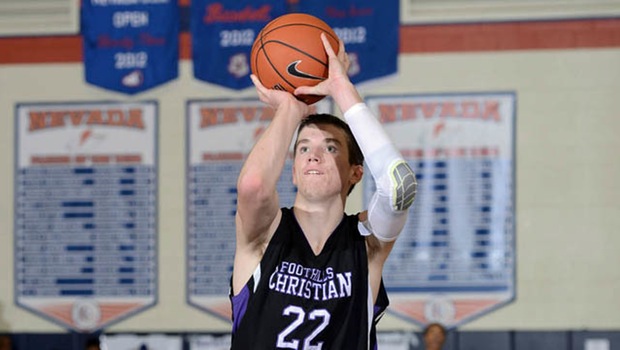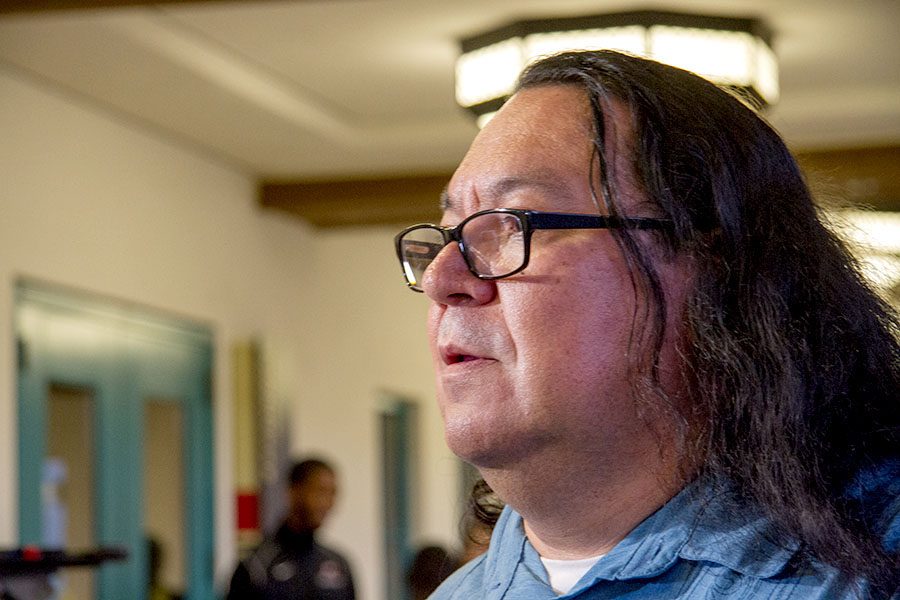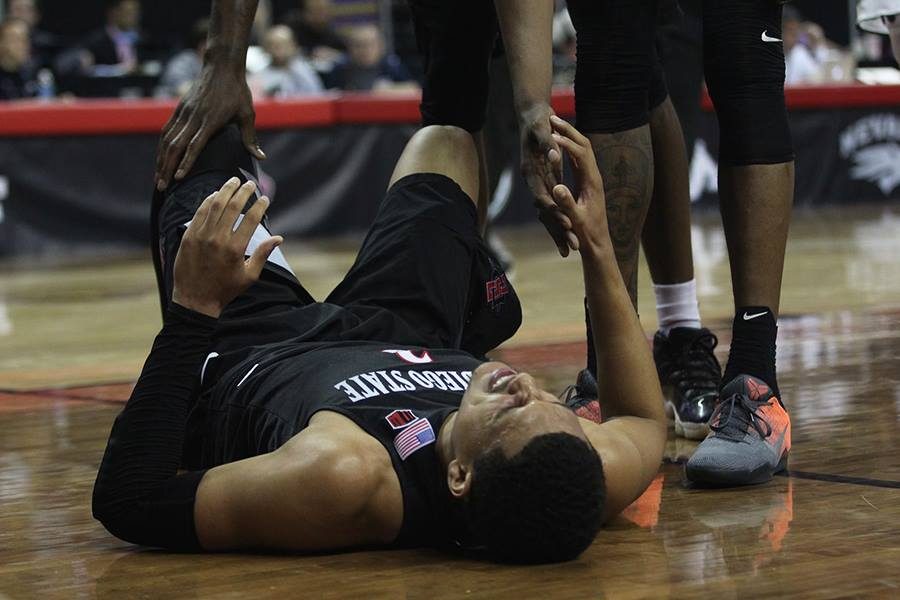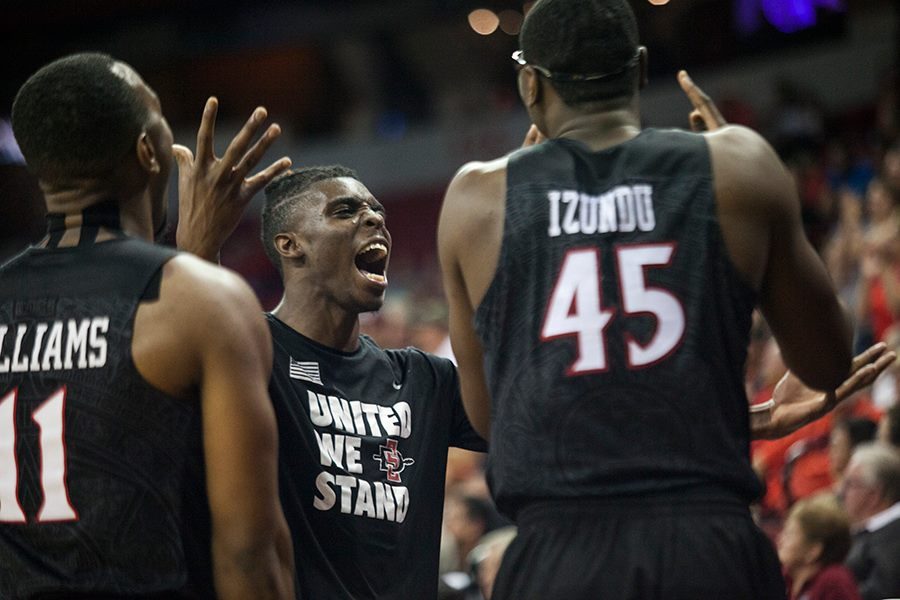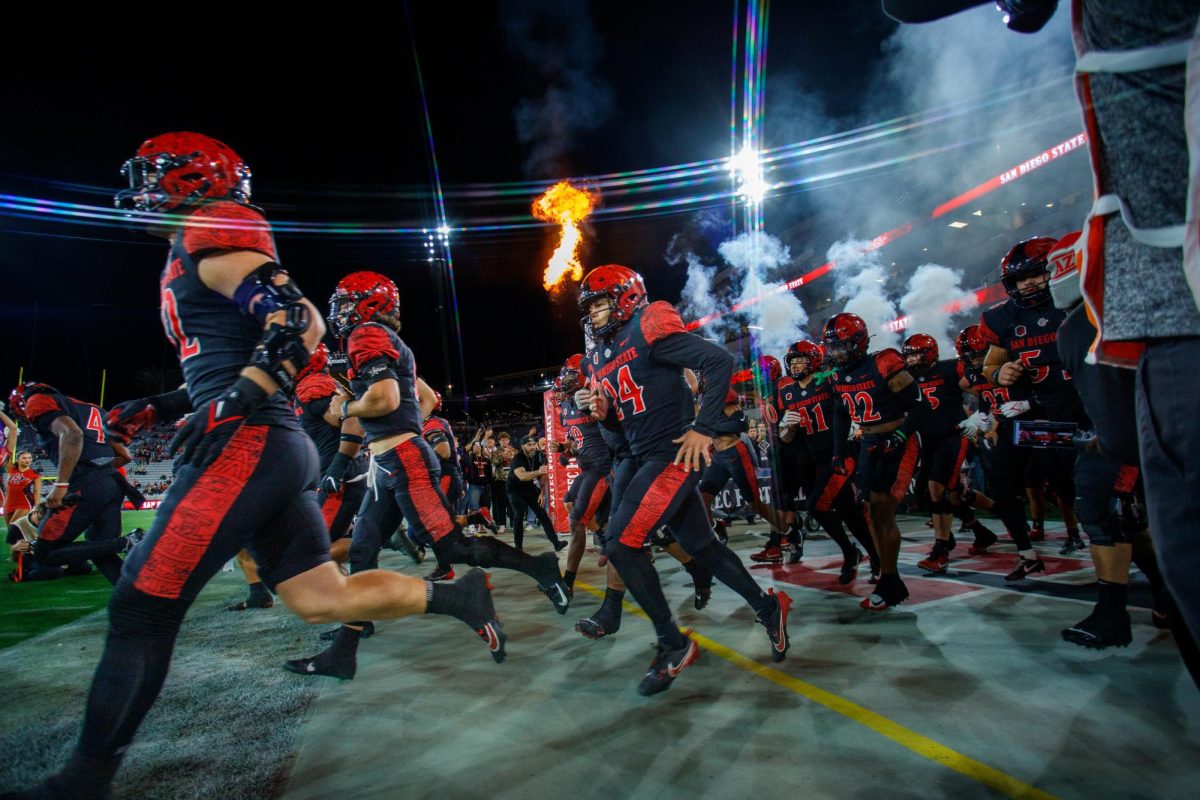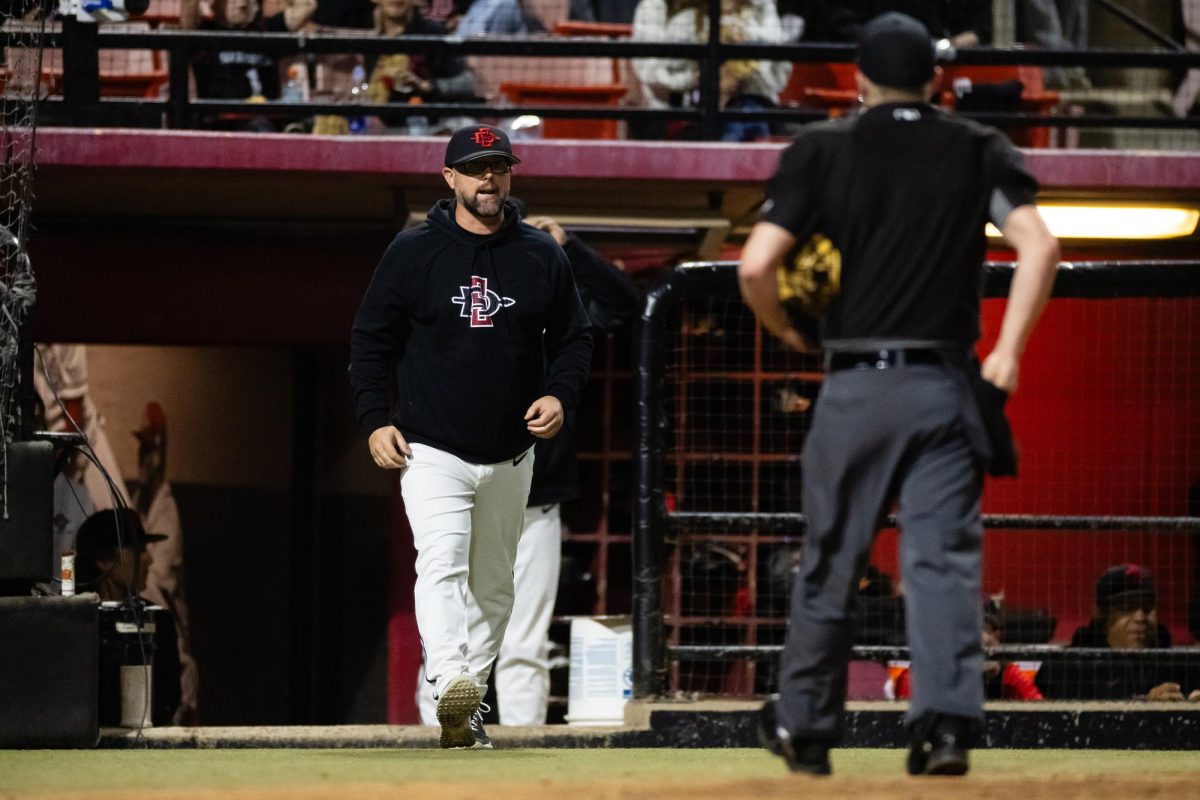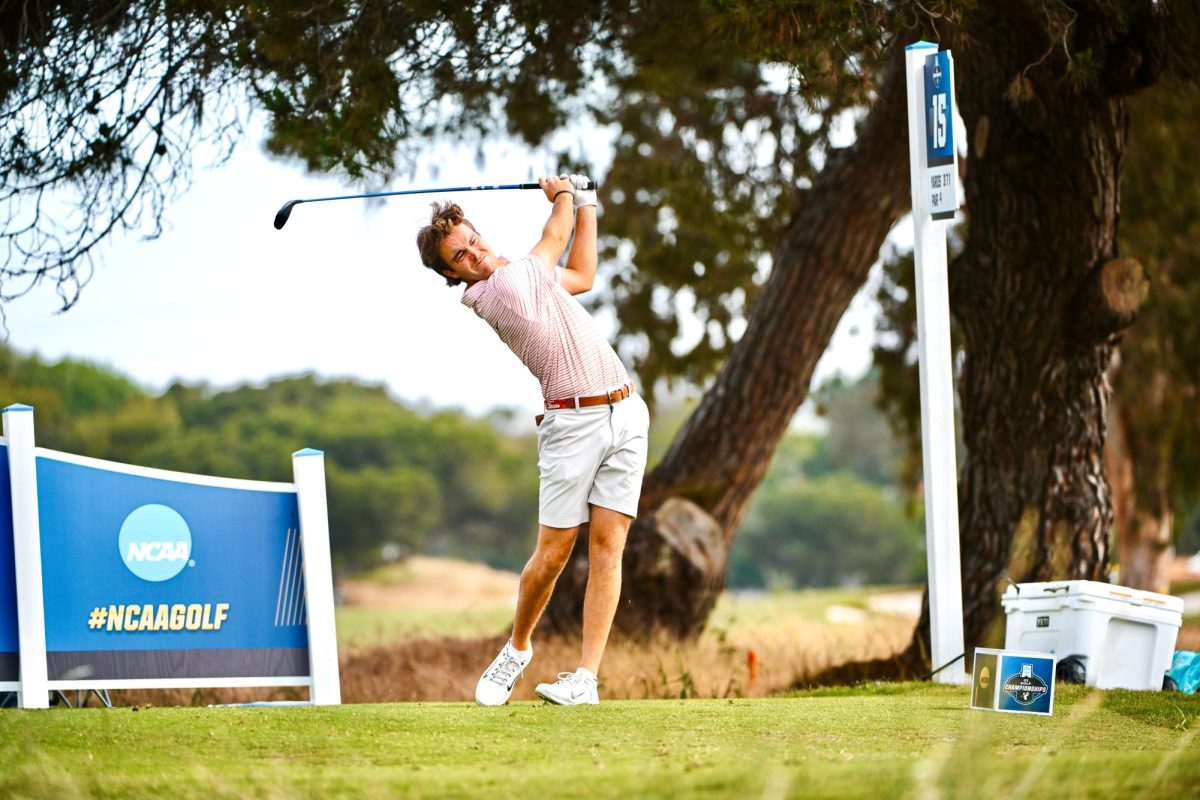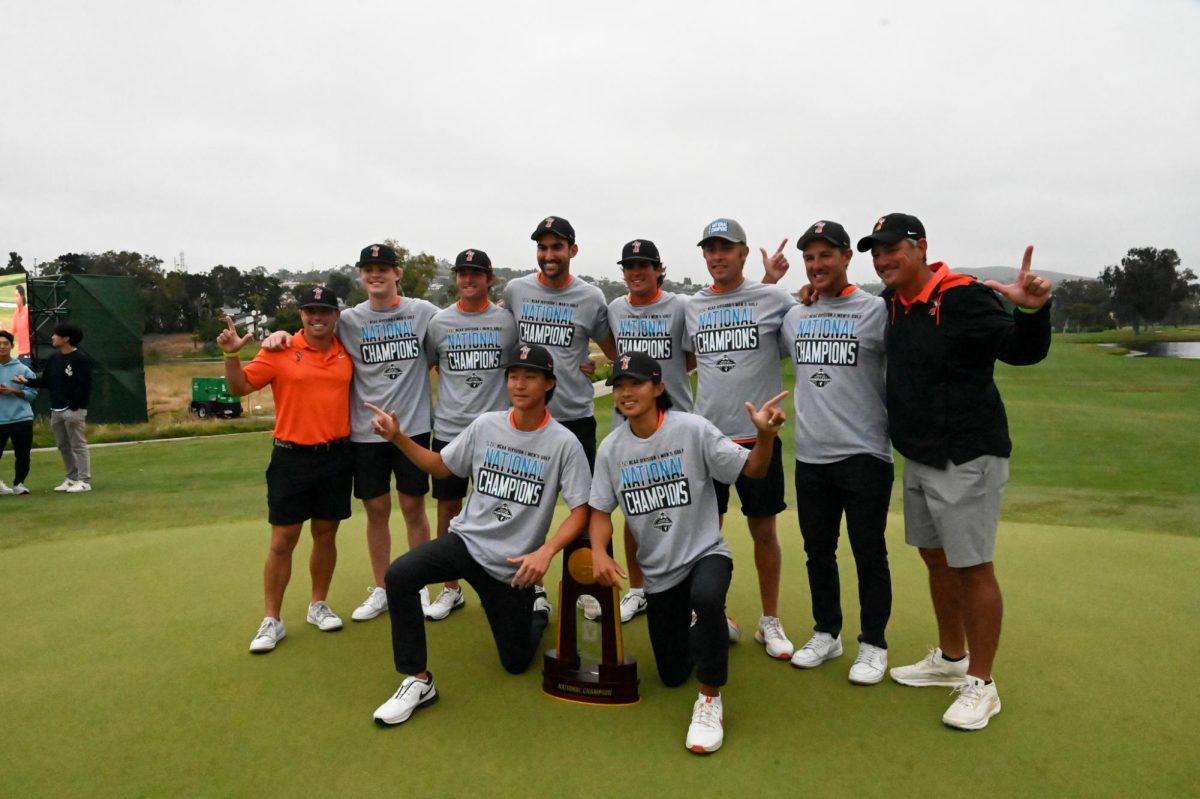On Nov. 2, San Diego State men’s basketball reminded San Diegans that they didn’t have to pay attention to the flaming pile of debris that masquerades itself as an NFL franchise.
SDSU beat Cal State San Marcos 86-48 in what appeared to be an insignificant preseason game — a tune-up to this Friday’s regular-season opener against Illinois State, head coach Steve Fisher’s alma mater.
What’s significant about the CSUSM game, though, is not what happened on the court, but who was there off the court.
Two highly coveted high school basketball players, T.J. Leaf and Brandon McCoy, watched along with around 10,000 others as the Aztecs dominated the Cougars.
Leaf is a 2016 power forward at Foothills Christian High in nearby El Cajon. Rated five stars by major recruiting services, Leaf initially committed to play basketball for Sean Miller and the University of Arizona.
But Leaf decommitted, coincidentally after being left off the U.S. Under-19 team that Miller coaches over the summer.
Leaf committed to UCLA on Thursday, giving the Bruins one of the best power forwards on the West Coast. ESPN rated him the No. 13 overall 2016 prospect and Rivals.com has him at No. 15 overall.
What’s significant is how Leaf is a part of two noticeable trends in college basketball: the sudden recruiting war between SDSU and the University of Oregon, and backing out of an oral commitment.
Enter: The Oregon Ducks
Leaf, like some other SDSU targets, shares something in common. They’ve been heavily recruited by Oregon and SDSU, who have become fierce recruiting rivals in the past year.
That’s not to say SDSU isn’t competing head-to-head with the likes of UCLA, Arizona and UNLV. These rivalries have been going on for awhile, but the reasoning is simple: geography and familiarity. Apart from the West Coast, there’s not too much in common between Oregon and SDSU.
Keith Smith, the principal at Seattle’s South Lake High and father of the former SDSU commit of the same name, said this head-butting between the Ducks and Aztecs is pretty significant considering the other top-tier programs on the West Coast.
“You immediately think of UCLA because of the tradition there, you think of Arizona then you think of Gonzaga,” Smith said. “Then you look at Oregon and they’re trending upward, and I think SDSU is a top-five program on the West Coast.”
Out of the 10-15 schools the younger Keith Smith was originally considering, it eventually came down to just SDSU and Oregon when he initially committed to SDSU in February 2015. He decommitted from the Aztecs in April, then chose the Ducks a week later.
With Leaf, he had 10 schools on his list after he decommitted from Arizona.
Before his Thursday decision, Leaf was down to UCLA, SDSU and Oregon, with the Ducks and Aztecs pursuing Leaf hard, but with UCLA the odds-on favorite. It’s unknown how highly regarded SDSU and Oregon were in Leaf’s mind at the commitment, but they both pursued him hard.
Leaf took official visits to Oregon and UCLA back in October, and took an official visit to SDSU before the exhibition, although he’s reportedly made many unofficial visits due to his close proximity.
The older Keith Smith, who played at Loyola Marymount University from 1982-86, said it’s a beautiful thing that the recruiting scene on the West Coast is so competitive.
“Kids are going to get recruited by these schools,” he said. “It’s a serious power struggle trying to get the best athletes out here.”
The Daily Aztec’s phone calls to the younger Smith’s AAU club (NorthWest Xpress) seeking more insight to the trend went unreturned.
Smith’s high school coach at Rainier Beach, Mike Bethea, said he wasn’t heavily involved in Smith’s recruiting process and couldn’t speak to the trend.
But the players Oregon and SDSU have fought for aren’t limited to just Smith and Leaf.
The curious case of Michael Cage Jr.
Perhaps the most notable meeting in this unlikely West Coast rivalry before Leaf was with Michael Cage Jr., the Santa Ana Mater Dei power forward and son of SDSU legend Michael Cage.
The younger Cage took his official visit to SDSU the first weekend of September to coincide with a volleyball tournament that his older sister, Alexis, was playing in for the Aztecs.
A week-and-a-half after Cage Jr.’s official visit, news broke on a Tuesday of a potential NCAA investigation surrounding Aztec men’s hoops.
Three days later on a Friday, Cage was on his way up to Eugene, Oregon, for his official visit to Oregon, with thoughts swirling of a dark NCAA cloud hanging around SDSU.
He committed to Oregon a week later after initially having overwhelming odds of playing for the Aztecs because of his father’s legacy at the school. Some suspicion has been cast as to the timing of the report at Cage’s commitment, as well as scrutiny heaved toward the CBS Sports report about the investigation.
The history between SDSU and Oregon
SDSU and Oregon met on the recruiting trail as early as 2012-13 when they were recruiting Malik Pope. The Ducks weren’t a front-runner and SDSU wasn’t supposed to be, either.
Pope, a sophomore forward, is now with the Aztecs after they recruited him hard while he was recovering from surgery on a broken leg.
The Daily Aztec reached out multiple times to Pope’s AAU coach, Lehron Dodson, and didn’t receive a response.
SDSU redshirt-sophomore guard Montaque Gill-Caesar transferred to the Aztecs this summer after leaving the University of Missouri. At 6-foot-6, he’s a phenomenal athlete that, like many SDSU transfers before him, fits right into head coach Steve Fisher’s system.
The two schools it came down to for Gill-Caesar were Oregon and SDSU.
Gill-Caesar’s former AAU coach, Tony McIntyre, said Gill-Caesar handled the transfer process on his own. McIntyre did say Gill-Caesar’s rationale for choosing SDSU was that he wanted to be at a school he felt most comfortable at, but otherwise he couldn’t speak to the recent battles between SDSU and Oregon.
SDSU and Oregon don’t actually share too much in common. They play in different conferences — Oregon in the Pac-12 and SDSU in the Mountain West — and the two haven’t squared up on a basketball court since 1997. The all-time series is tied 3-3.
Well, the two programs do have two things in common: They’re both on the West Coast and their head coaches have gone about building their programs in a somewhat similar fashion.
Dana Altman at Oregon and Steve Fisher at SDSU have relied on transfers the past few years. In 2013-14, Altman had nine transfers on his team. The next year, he had seven. Now he has five. Last year’s Pac-12 Player of the Year, Ducks guard Joseph Young, transferred from the University of Houston.
Fisher has four transfers on his roster this year, but that number in the past has been higher. It was five last year, seven in 2013-14 and nine the previous year.
Xavier Thames, who somewhat single-handedly guided the Aztecs to the Sweet 16 in 2013-14, was a transfer from Washington State whom SDSU tried and failed to replace last year.
Brandon McCoy, a five-star 2017 center from Cathedral Catholic High, like Leaf, went to the Nov. 2 exhibition and has multiple suitors up and down the West Coast. The two schools who are fighting neck-and-neck for his signature?
Oregon and SDSU.
“Oregon said Brandon is their No. 1 recruit,” said Will Cunningham, the boy’s varsity basketball coach at Cathedral.
Aztec coaches, including Fisher and assistant coaches Brian Dutcher and Justin Hutson have watched McCoy play and practice many times, according to Cunningham. So have the Ducks’ coaches, including Tony Stubblefield.
Neither Oregon or SDSU is the school that’s recruiting McCoy the hardest. That would be Arizona, the perennial West Coast recruiting power that routinely beats both schools to high-profile recruits.
So what’s next in this saga between Oregon and SDSU? A lot, actually.
McCoy and the other 2017 players’ recruiting process will start to heat up as this year goes on. SDSU and Oregon have more players in their sights than just McCoy. Class of 2017 point guard Markus Howard from Findlay Prep in Las Vegas and Greg Floyd Jr., also from Las Vegas, are reported SDSU targets.
Two others are power forward Ira Lee, from Chatsworth, and small forward O’Shea Brissett at Findlay Prep.
The fact that SDSU and Oregon are breaking into this fraternity of UCLA, Arizona and Gonzaga means the older Keith Smith has a lot to look forward to.
“West Coast basketball is on the rise, it’s right there at the top again like it was back in the day,” Smith said.
Is backing out of an oral commitment becoming a trend?
When 2016 Rainier Beach High (Seattle, Washington) small forward Keith Smith committed to SDSU in February 2015, the Aztecs appeared to have gotten a player who was long, athletic and had a nice shot. That was nearly 18 months before he could even don a college uniform.
Smith decommitted from the Aztecs in April, then committed to Oregon a week later.
Right across the street from Rainier Beach High is South Lake High, where Smith’s dad, also named Keith Smith, is the principal.
He recalled a conversation with his son when he decommitted.
“He said, ‘Dad I might’ve been premature in making a choice,’” Smith said. “’I really want to look at all my options. San Diego State is still a place where I might want to go, but I want to explore my options a little more thoroughly.’ It was tough for him to say that, let alone do it. He had just turned 17.”
High school players are committing to their future schools years in advance. The current signing period is a year away from the start of next year’s college hoops season.
Another Aztec 2016 target, Brendan Bailey from American Fork, Utah, initially committed to Arizona State before backing out and picking Marquette University.
Bailey, who actually announced he will take a Mormon mission and not go to college until 2018, committed to ASU nearly two — or in this case four — whole years before he’d be eligible to put on a Sun Devils jersey.
Leaf committed to Arizona nearly two years before he would even be able start attending. His AAU teammates, Jalen Hill and Jaylen Hands, committed in June and September 2015, respectively. They’ll both arrive on UCLA’s campus in the fall of 2015, just under two years from now.
Four years at one school seems like an awfully long time when Vines last six seconds. It doesn’t help that kids commit sometimes more than two years out.
That’s a lot of time for another school to come in and poach that player, or for an NCAA investigation to creep up on a school or, in Bailey’s case, for a coach to leave.



